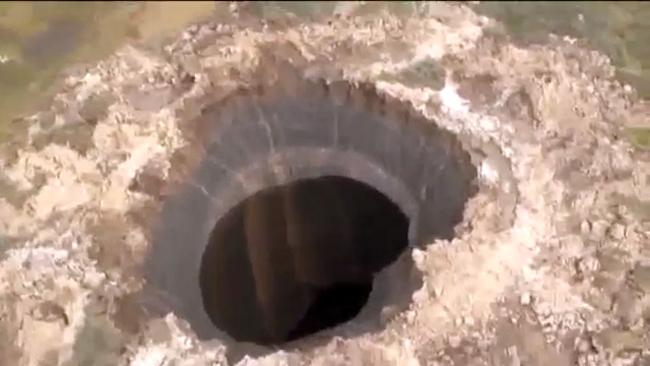A mysterious crater in Siberia has scientists seeking answers: Was it a meteor, an alien or global warming?
News.com.au
The seemingly bottomless pit was spotted by an oil-and-gas industry helicopter flying over northern Siberia — a region notorious for devastating events.
It certainly is Armageddon. The place where it has been found is known as Yamal, meaning “the end of the world”.

Remote impact … The stain of upturned turf and the blackness of a pit stands out starkly against the permafrost of remote Siberia. Source: Supplied
The most deadly meteor impact of modern times — The Tunguska air burst — happened in the region in 1908. It flattened vast swathes of forest over a 2000 square kilometre area.
No such streak in the sky, flash of explosion or seismic event has been recorded recently.
But this mysterious hole has nevertheless appeared.
The Siberian Times reports startled helicopter passengers talked their pilot to loiter over the mysterious crater. Engineer Konstantin Nikolaev then filmed the hole and uploaded the footage to YouTube.
They say the hole was big enough for their helicopter — an 18 metre long Mi8 — to have comfortably entered without touching the sides.

Into the abyss … The Russian helicopter flew over the mysterious crater, reporting the hole to be several times larger than their helicopter. Source: Supplied
RUMOURS AND REALITY
Since the footage appeared online, the internet has been abuzz with rumours of UFOs, secret entrances to the “hollow-Earth” — as well as the more mundane weapon test sites and meteorite impact theories.
“We can definitely say that it is not a meteorite,” a spokesman for Russia’s Emergencies Ministry has told media.
Russian scientist Anna Kurchatova, from the Sub-Arctic Scientific Research Centre, believes the cause is something more logical, such as global warming.
Siberia’s frozen soil — known as permafrost — contains millions of tons of methane gas. As the surface slowly warms, this gas begins to be released — and pools into highly volatile pockets.
A mixture of water, salt and gas may have ignited an underground explosion. Another possibility is that the gas pocket may simply have built up enough pressure to pop like a Champagne cork, she said.

Bottomless pit … What appears to be sand may be cascading into the depths of a Siberian methane-gas blowhole, an ominous sign for global warming. Source: Supplied
SEARCH FOR ANSWERS
Clues to the crater’s cause are not far away.
‘A scientific team has been sent to investigate the hole and is due to arrive at the scene on Wednesday (tomorrow Australian time),’ The Siberian Times reports.
The expedition includes experts from Russia’s Centre for the Study of the Arctic, and the Cryosphere Institute of the Academy of Sciences.
They will sample the soil, water and air at the scene in order to determine the nature of the blow hole.
The crater was found in the Yamalo-Nenets Autonomous Region, some 40 kilometres from the Bovanenkovo gas field. The peninsula, which sticks into Arctic waters, is the source of Russia’s vast gas export market to Europe.
